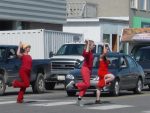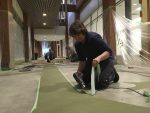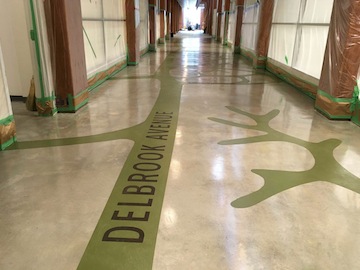LINK Dance Foundation will perform Why did the Chicken Cross the Road? at a few intersections in Vancouver during Dancing on the Edge. (photo from DOTE)
As part of this year’s Dancing on the Edge festival, which takes place July 6-15, LINK Dance Foundation will explore the age-old question, “Why did the chicken cross the road?”
“The idea for Why did the Chicken Cross the Road? came about through various stages, like all things do,” said Gail Lotenberg, founding artistic director of LINK. “The germination to the actual realization was a process and it is still in development for the future.”
DOTE producer Donna Spencer invited Lotenberg to be involved in this year’s festival with a specific piece, but the timing wasn’t right. “So, I told her I had another idea for this year if she was open to it. We had a meeting and together we cooked up this piece,” said Lotenberg.
Leading up to the 2013 provincial election, she said, “I wanted to help attract young people to exercise their right to vote, so I spearheaded a dance performance at the intersection of Davie Street and Granville Street with signage from Rock the Vote BC.
“The dance did not deliver overt messages about voting (though there were subtle motifs in the choreography), rather it aimed to stop people in their daily lives to enjoy viewing a quick dance by an ensemble of dancers as they crossed a busy intersection. We had people stationed at the corners to hand out pamphlets with more specific information about voting day.”
The concept was introduced to Lotenberg in 2005 by a “close friend and colleague, Cara Siu, who came to Whitehorse, Yukon, when I used to live there. At that time, I was producing an annual festival called Dancing in the Streets. She came from Vancouver to make a dance at the intersection of two main streets in Whitehorse as part of the week of outdoor dance performances. I loved the idea and always knew I would use it again.”
For the 2017 incarnation, Lotenberg said she wanted to “include a large pool of less-well-known dancers in the community in a site-based work at intersections” and Spencer was all for it.
“In fact,” said Lotenberg, “it was her idea to involve young dancers from pre-professional training programs in the project. She also saw the benefit of having DOTE volunteers on the corners to provide more information to people about other shows they could see during the annual summer festival. Donna really helped to make the idea crystallize into what it is now, a work for eight dancers – mostly young dancers in the final stages of their training with the exception of two professionals. The two dancers who would normally be considered out of their training stage … will perform my core idea of a duet between pieces of white cloth to complete the show.”
Lotenberg, however, won’t be performing. “I will not be dancing in this work,” she said, “unless I’m wearing a chicken costume.”
She hopes “Intersection Interventions” will become “an annual part of DOTE, in the way Dusk Dances were a signature aspect of the festival for almost a decade.”
She said, “I believe in public art. I see myself as someone who evolved from the same fabric as the public frivolity movement of the 1990s – Unsilent Night, flashmobs, etc. These are acts of art that enhance our civic arena.
“I like art that engages people in community and invites people briefly into the humanizing experience of co-creating art. I don’t like art that does this by ignoring the principles of composition and virtuosity and esthetics, meaning they are inclusive but not very entertaining. So, I strive to find the duality that makes work provocative and pleasing to view, while at the same time offering some type of invitation to be an active rather than a passive participant.”
From 2008 to 2012, Lotenberg was an associated artist with Simon Fraser University’s Centre for Dialogue. The academic director of the centre then, Mark Winston, supported many of her endeavours, she said, “because he saw my work as a model for how to employ art as part of public engagement and how to construe social engagement as fertile soil for making art. I am grateful to Mark for that period of cross-pollination of ideas and expertise. He, too, is a Jewish person and together we mined the depths of what it meant to be Jewish and engaged in our mutual professions, he as a scientist and director of the CFD, me as a dance artist and director of a dance company.”
She said, “When I was a younger artist, there was a hierarchy in my mind that put work onstage above public-engaged art practice. Then I met Liz Lerman, a famous populist choreographer from the U.S., and I shifted my perspective to a less hierarchical model.
“I love seeing how dance can enter the public domain and engage people in something that lives between the opposing ends of a spectrum. On the one hand, you have pure social dancing that is non-performative but fully inclusive and, on the other end, you have very formal dance performance, which occurs on a stage with no apparent involvement from the audience except as witness. I love the in-between.”
Over the course of her dance performance and choreography career, Lotenberg has created many works that combine dance and activism.
“I’m a political person,” she said. “I grew up that way. As a Jewish person, I was taught to think in terms of how I could contribute to making the world a better place. I use my attributes as a choreographer to bring people together in a way that feels beautiful or powerful or profound or just fun.
“Take the Occupy Movement, for instance. I see something like that and I think, ‘Oh, imagine how easy it would be to occupy more space by getting people to not just stand around and chant but rather to do a square dance, which inherently takes up a lot more space.’ In occupying space with a square dance, people are using dance politically and the results are varied. People are having more fun. Authorities may not feel so threatened because the impulse is to relish life, not to be destructive, which is true of most political movements that are not hate-based. So, dance for me is an interface between the institutions we hope to shift and the people who are trying to have sway in shifting those institutions.”
Being Jewish has informed Lotenberg’s way of engaging with the world in various ways.
She said, “Being Jewish made me a political person and that feeds an aspect of my choreographic interests…. Being Jewish also surrounded me with people who embrace ritual and ritual is an important aspect of art. Being Jewish led to many opportunities to be in community through song and dance, and there is nothing more uplifting than that. In fact, I would say that these acts of sharing voice and song are what do connect me to my spirituality.
“And finally, I grew up as a New York Jew and my parents were very involved in the Civil Rights Movement of the 1960s. We moved to a town that was emerging as a leader in desegregation of schools, so I went to a school right from Grade 1 that was racially mixed.”
Lotenberg earned her bachelor’s degree at University of Michigan, was a dance teacher and skier in Crested Butte, Colo., for about five years and then did her master’s degree in history at University of Washington. In Seattle, she said, “I met a Vancouver boy, graduated, sold everything, moved here and then, within a year, we left for the Yukon.”
While Yukon was home from 1993, Lotenberg returned to Vancouver often for dancing. In 2007, she and her family moved to Bowen Island – “bad for my dancing career but otherwise wonderful,” she said.
Lotenberg took an approximately three-year break from dancing to be more present for her daughter, who has a learning disability, she said. “She’s good now. She’s strong and knows how to self-advocate for learning support that allows her to perform well in school. And, she basically is my happy place. But, I missed dance and being with other dancers – people who see and sense the world through a different lens.
“I feel gratitude at the opportunity to re-enter the dance milieu from the place I am today. I am grounded; I have a good job as a pilates instructor; I want to have my work seen and appreciated but that desire does not define me anymore. I am eager to share my work, but I feel strong and I feel confident and I trust that my work is valuable because it is honest and well-crafted and unique.”
Lotenberg is in the midst of developing a new stage work for next year’s DOTE in which she will be dancing.
“It is a piece I am challenging myself to take on because it feels important for me to step back into the dancing body to tell my story in a real and vulnerable way,” she said. “In fact, the application to show this work I’m describing is what actually led to having Why did the Chicken Cross the Road? happen at this year’s festival. Life is a beautiful journey that way. You sow seeds but you don’t always know how they will bear fruit.”
The promotional material for Why did the Chicken Cross the Road? asks the question, “Rather than walk, why not dance to get to the other side?” What can be gained from dancing, even if only across the street?
“Dancing is liberating,” said Lotenberg. “Dancing is frivolity and elemental connection (at the same time). Dancing is one of the first forms of art and, in some cultures, it is the glue that defines who they are, how they touch the earth with their feet and what is the rhythm of their heartbeat.
“I tried to leave dance and choreography to become a better mother. I did become a better mother but I also realized in that period that dance is essential to who I am.
“Dancing across the street,” she said, “is a way of celebrating life, is a way of being part of making the world a more beautiful place, is an invitation to be part of a happening that makes today just a bit more rich than yesterday or tomorrow.”
For the times and locations of Why did the Chicken Cross the Road?, visit dancingontheedge.org/program/chicken-cross-road. For the full DOTE schedule, visit dancingontheedge.org.



